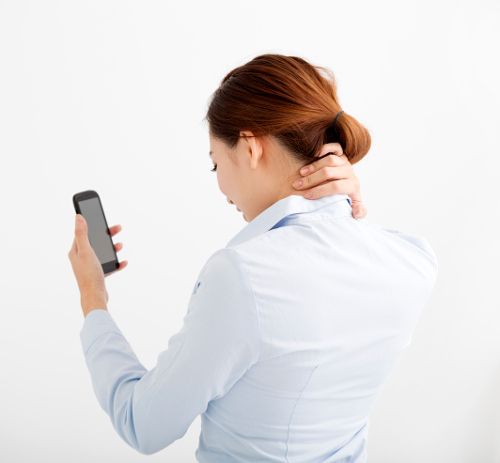
Credit: iStock.com/Tomwang112
We’ve all used the phrase “pain in the neck” to describe an irritating thing or person. As in, “The traffic this morning was a pain in the neck,” or “Flight delays are such a pain in the neck.” But honestly, those minor irritants are nothing compared to a real pain in the neck.
Especially if that pain is caused by a pinched nerve.
What Causes a Pinched Nerve?
A nerve gets pinched when there is excessive pressure on the nerve as it exits your spinal column. This pressure can be caused by narrowed spaces between the vertebrae, bone spurs, and tight muscles.
More recently, the popularity of “texting” has increased the occurrence of pinched nerves in the neck. The forward head posture you adopt while texting puts extra stress on your neck, so it can often cause a pinched nerve.
A pinched nerve in the neck can lead to localized pain, numbness, burning and tingling, and a hot/cold sensation. The pain can also radiate down the arms and into the fingers. And it can be accompanied by muscle spasms.
Because of the pain, a pinched nerve can limit your neck movements. This makes it difficult to do simple things like pulling your shirt over your head, looking over your shoulder when reversing your car, lifting your head off the pillow, tilting your head back in the shower, or even just turning your head.
So, the faster you get rid of it, the better.
How to Treat a Pinched Nerve
1. Rest
The most important thing to do is rest the neck. This means you should avoid sudden jerky motions and jolts, but also limit the amount of repetitive strain you put on your neck (like texting or playing a game on your phone too often).
2. Hot/Cold Compresses
If the pain is caused by a muscle spasm, you can relax your muscles by applying hot packs and ice packs alternately or taking a hot shower. You could also use a handheld massager.
3. Stretches
Another way to get relief is by doing a few gentle neck stretches. As you stretch the affected area, your body will release endorphins in response to the movement. Those endorphins can give you pain relief.
4. Diet
As your pinched nerve could be triggered by a calcium/potassium deficiency, eating a diet rich in calcium (spinach, kale, sesame seeds, low fat dairy, and seaweed) and potassium (apricots, bananas, avocados, cashews, walnuts, and avocados) can prevent the condition.
By following the above tips, you can ease the pressure on your nerve and possibly get total relief from the pain.
When to See a Doctor
However, if the pain does not subside, the cause of the pinched nerve might be something more serious, like a narrowed cervical disc or a bony spur. In which case, the earlier you see a doctor, receive a diagnosis, and begin treatment, the sooner your pinched nerve will stop being “a pain in the neck.”
Related Articles:
5 Treatments for a Pinched Nerve in the Shoulder Blade
How to Treat Neck Pain That Causes Nausea and Dizziness
Understanding Myelopathy vs. Radiculopathy: Causes and Symptoms
Sources
“Pinched Nerve Information Page,” National Institute of Neurological Disorders and Stroke; https://www.ninds.nih.gov/disorders/all-disorders/pinched-nerve-information-page, last accessed August 4, 2017.
“Cervical Radiculopathy (Pinched Nerve),” OrthoInfo; http://orthoinfo.aaos.org/PDFs/A00332.pdf, last accessed August 4, 2017.
Gustafsson, E., et al., “Texting on mobile phones and musculoskeletal disorders in young adults: A five-year cohort study,” Applied Ergonomics, Jan. 2017; 58:208-14; https://www.ncbi.nlm.nih.gov/pubmed/27633215, last accessed August 4, 2017.
